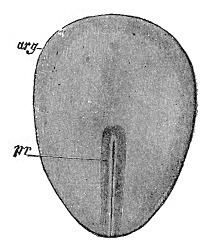Carnegie stage 4 Code TE E2.0.1.2.0.0.14 | Latin discus embryonicus | |
 | ||
The floor of the amniotic cavity is formed by the embryonic disc (or embryonic disk) composed of a layer of prismatic cells, the embryonic ectoderm, derived from the inner cell-mass and lying in apposition with the endoderm.
In humans, it is the stage of development that occurs after implantation and prior to the embryonic folding (e.g. seen between about day 14 to day 21 post fertilization). It is derived from the epiblast layer, which lies between the hypoblast layer and the amnion. The epiblast layer is derived from the inner cell mass. Through the process of gastrulation, the bilaminar embryonic disc becomes trilaminar. The notochord forms thereafter. Through the process of neurulation, the notochord induces the formation of the neural tube in the embryonic disc.
